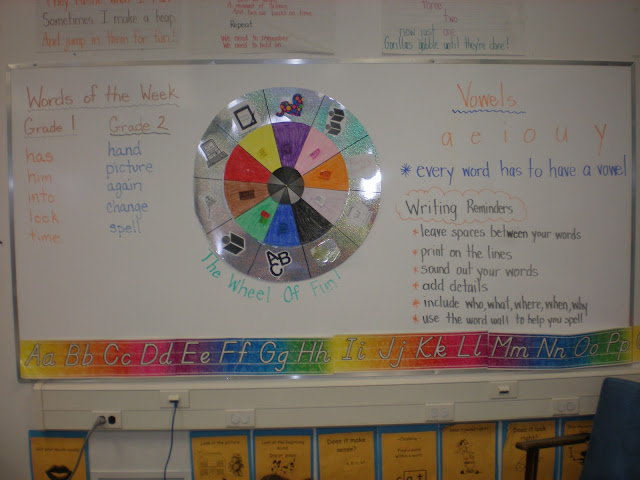Working with small groups, in guided reading, is an integral part of Donna and Wendy's literacy block. In order to be able to do that, they use literacy centres. Seeing as they are in a shared space with both of their classes, they have combined the types of activities that are used and have mixed the groups, having students work together from both classes.
They have created "The Wheel of Fun" and student names are in the middle circle and rotated each time there is guided reading, to a new centre. At this time, Wendy and Donna each see a group to work with: Wendy works with reading and Donna works with writing.
While they work with a group, the others are focused on an activity to reinforce content learned or a literacy, and math, concept. Workstations such as independent reading, reading around the room, computers, writing with a prompt, poetry work, etc. are embedded so that students are working on a task that they are able to do independently, with their group, without interrupting the teachers.
At the beginning of the year, there were not as many activities to choose from, as each station had to be introduced slowly, one activity each time, and expectations had to clearly be laid out.


Here are some pictures of their students at the different workstations:
Computers: Students work on different internet sites, like Starfall, reading and writing.


Independent Reading: Reading on their own, or with a partner, helps students apply the strategies and skills taught in their reading lessons. Here, one student is able to use this PVC pipe that Donna has made, to read into to hear herself reading.


Reading Around the Room: Using these big crayons as pointers, students read the room together, pointing to words they know, and to the visual print in the room.

Printing: In order to help students develop their printing skills, they work at one station practising to write the different letters.

Poetry: Using one of the shared reading poems that they have already worked with, Donna and Wendy put their sentences from each poem on a sentence strip and students have to work together to put the poem together, sequencing it correctly and reading it together.


Reader's Theatre: In the drama centre, Wendy and Donna have prepared puppets from The Three Billy Goats Gruff, a story that students are familiar with. They retell the story orally together, using the puppets to guide them.

Writing: Using a different prompt, students work on writing about a topic. In the next rotation, this group works with Donna, and they work closely with their writing, focusing on developing their ideas, conventions, word choice, etc.



Math Station: Here students work with a math concept connected to their math program. Building their spatial sense, students work with tangrams to figure out the puzzle.
While students are working, Wendy and Donna have a chance to work with a small group, or conference one-on-one with their students on their reading. Here, they are administering the DRA, completing individual reading conferences to see how their students have improved in reading. Completing these reading conferences and assessments frequently is so important as it helps track what the needs of their students are and informs their practice so they know what to focus on and where to go next.
Wendy wears this lei to let her students know that she cannot be disturbed as she is working with a student.


Donna and Wendy keep their running records in a notebook, in addition to using the DRA running records, to help manage and organize all of the paperwork and notes. Many teachers either use this notebook method or keep track with a running record line master (included in the DRA kit or in the Reading in Toronto District Schools binder).



Wendy is working with a guided reading group, guiding them through their text.
Donna is working with a guided writing group, following their writing time from the previous rotation. She is working on word families with them, as this is the need for this group. Students work together and share the pen to come up with words they know in the -at family.
The workstation icons that Donna and Wendy use can be found in this resource, by Fountas and Pinnell. They outline what guided reading is, what it looks like and how to organize the time to be the most effective.
For more information and for video examples and printable documents about guided reading, go to eWorkshop, an online resource developed for elementary teachers in Ontario. Guided Reading - eWorkshop









No comments:
Post a Comment